Menu
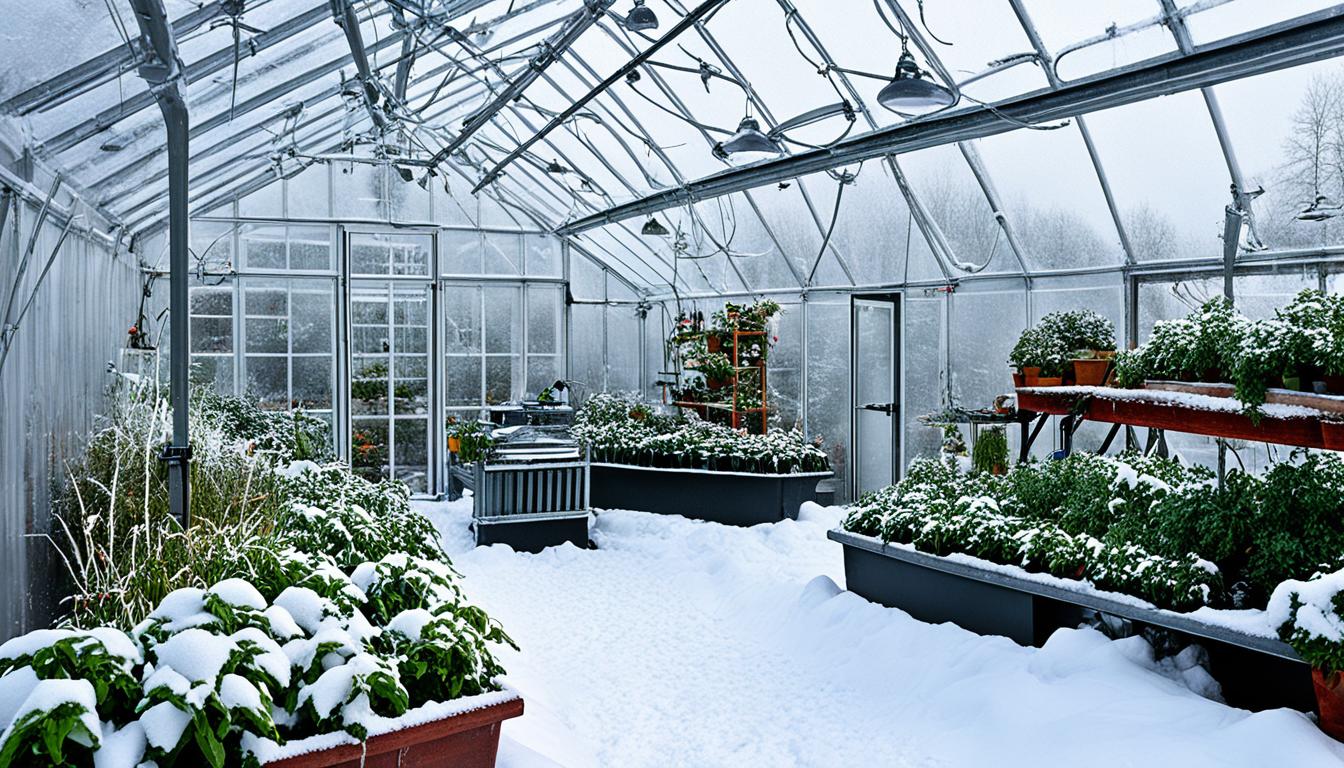
Did you know there are about 5 crucial steps to get your greenhouse ready for winter? With the cold taking over, it’s key to use smart methods for managing your greenhouse. This ensures your plants stay alive and productive. These methods include top-notch insulation and heating to fight the cold and lack of sunshine.
By using energy-saving heaters and extra lights, your greenhouse can become a warm, bright space for plants. They protect your plants from frost and create ideal growing conditions. Also, getting financial help through grants and tax breaks for upgrading your greenhouse is a smart move. It helps cut down costs and makes the greenhouse greener.
Keeping a greenhouse warm in winter is key, both for plant health and for saving money. Good insulation reduces the need for heating, cutting energy use. Starting with the right walls, materials like twin-wall polycarbonate trap air for better insulation.
Insulation materials for greenhouses vary, each with its own insulation power. Here are some common options:
Additions like polyethylene and polyester, when used to make thermal curtains, keep heat in. This lowers the cost of heating the greenhouse.
Insulating your greenhouse can improve plant care in winter and save money. Let’s look at the benefits:
| Material | R-Value |
|---|---|
| Fiberglass | 4.0 |
| Expanded Polystyrene (Smooth) | 5.0 |
| Polystyrene Beadboard | 3.6 |
| Expanded Polyurethane | 6.2 |
| Plywood | 2.8 |
| Sheet Metal Wall | 0.78 |
Greenhouse gardening in winter can be hard and cost a lot to keep warm. However, using energy-efficient heating systems can really help save money. Let’s look at some good options to keep your greenhouse warm:
Geothermal heating uses the Earth’s warm, steady temperatures underground. This makes it a green and efficient way to heat greenhouses. Owners save a lot on heating bills and help the planet at the same time.
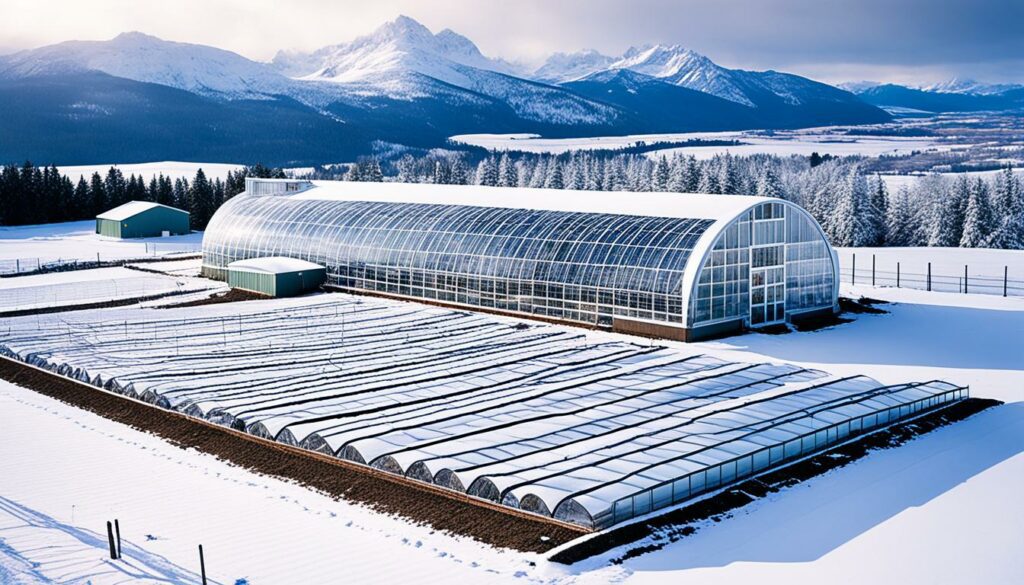
Infrared heaters are a smart choice for winter gardening. They heat objects directly by emitting a special type of heat. This is perfect for greenhouses with good insulation. It gives plants the warmth they need, even in very cold weather.
Biomass heaters are good for those who want a green option. They use wood chips or pellets to make heat. This not only warms plants well but also turns leftover organic matter into useful energy.
Heat pumps move heat around instead of making it. They are a smart, energy-saving choice for winter. They can use the air or ground’s heat to keep the greenhouse at the right temperature. Plus, they can save money when paired with energy rebates and tax breaks.
It is key to pick the right heating system for your greenhouse. Think about the size, how well it’s insulated, and the climate where you are. This way, you can choose a system that is good for the planet and your wallet.
In winter, there’s less natural light for plants, affecting their growth. But, adding extra light can help them stay healthy and grow well. LED lights are a great choice because they save energy, and you can adjust how bright they are. This change to LED can even save you money, thanks to rebates from utility companies.
There are different lights you can use in a greenhouse to help your plants. LEDs are the top pick because they are energy efficient and good for all plant growth stages. Another option is HPS lights. They shine bright but are not as efficient as LEDs.
The type of light is very important for plants. A mix of blue, green, and red light is best. Blue light helps with growing leaves and stems, while red light is for blooming and fruiting.
To use light well, it’s key to know how much light your plants need daily. Machines that adjust the light automatically can make this easier. They help keep the plants happy without spending too much on power or workers.
Using the right lighting not only makes your plants thrive. It also saves you money, thanks to help from utility companies. This approach makes sure your plants get the light they need all winter.
| Supplemental Lighting Type | Efficiency | Benefits |
|---|---|---|
| LED Lights | High | Energy-efficient, adjustable intensity, full spectrum |
| HPS Lights | Moderate | High intensity, effective for flowering |
| Fluorescent Lights | Moderate | Good for seedlings and vegetative growth |
Effective winter greenhouse management is all about being ready and making adjustments. Keeping the right environment in cold months is key for plant health. Some main actions help plants grow well, even in the cold. They make sure crops actually do well, not just survive.
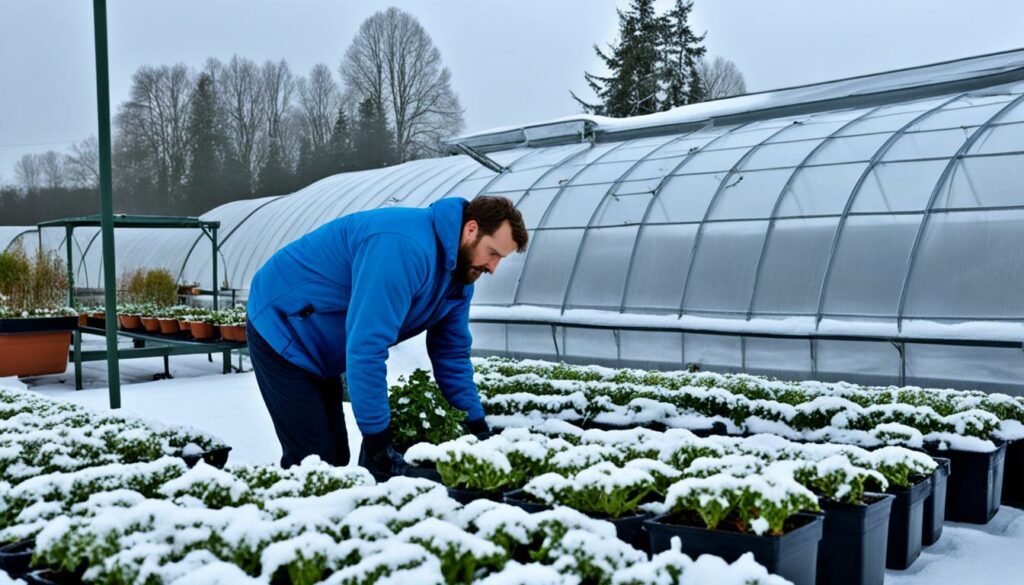
Insulation is vital for winter greenhouses. Using materials such as polyethylene and aluminium, you can make thermal curtains. These, along with insulative glazing like bubble wrap, keep the warmth in. This means you don’t need to heat the greenhouse as much.
Using heaters smartly is also important. Geothermal heating uses the earth’s warmth. Electric heaters and heat pumps adjust the inside temperature well. This keeps costs down and plants healthy.
Light is a must on short winter days. LEDs and extra lights make up for less sun. They also help plants grow strong. Knowing about light and placing lights well improves how well the greenhouse is lit.
Good airflow and tracking temperature closely are necessary in winter. Machines that control heat and humidity make a comfortable space for plants. This stops fungi and keeps the air clean.
Beating winter pests and diseases is critical too. Use bugs that help and natural bug sprays (like neem oil) to keep the greenhouse thriving. This is a good way to fight pests without hurting the environment.
All these steps are needed for a well-run winter greenhouse. Planning well, using resources effectively, and always watching can turn winter into a growing time.
In today’s world, modern greenhouses use automated control systems. These systems have changed how we take care of plants. They help by making sure the environment is just right for plant growth.
These systems have a few main parts to help with greenhouse maintenance. Climate controllers keep an eye on the temperature and humidity. They make sure the greenhouse climate is perfect for plants. There are also mechanical systems controllers. They handle things like fans and irrigation. Sensors in these systems can water plants automatically. This saves time and effort for the farmers.
There are many good things about using automated systems in greenhouses. One key benefit is how well they control the environment. This keeps moisture and heat at the right levels. It also helps save energy, making the whole process more efficient.
The best part is, growers can set these systems to fit different plants. This helps each type of plant grow as well as possible. The end result is plants that grow better and more consistently.
Automated control systems let you control many areas in a greenhouse all at once. This makes running a greenhouse smoother. It also helps save on time and cost, making crop care more efficient.
You can even manage the greenhouse from afar with these systems. This means the greenhouse can be taken care of, no matter where you are. It’s a big plus for busy growers.
| Key Benefits | Description |
|---|---|
| Time and Resource Savings | Programmable irrigation and automated fertigation streamline operations. |
| Temperature and Humidity Control | Maintains stable environmental conditions crucial for plant health. |
| Customisable Settings | Allows growers to meet specific crop needs. |
| Multi-Zone Capabilities | Enables control of several zones from a single source. |
| Energy Cost Reduction | Facilitated by precise environmental control. |
| Integrated Equipment Operation | Enhances efficiency by ensuring coordinated system operation. |
| Remote Management | Allows for off-site monitoring and adjustments. |
| Consistent Environmental Control | Leads to uniform growth and higher-quality crops. |
Finding the best crops is crucial for winter greenhouse success. Select cold-tolerant, sturdy plants. Leafy greens like kale, spinach, and different lettuces do well. They offer both nutrition and cope with winter’s changing temps. Look here for more on winter crops.
Root veggies, such as carrots, beets, and radishes, are great for cold times. They grow underground, protecting them from frost. Their toughness means they still grow in tough conditions. Herbs like parsley, cilantro, and chives add fresh taste all winter long.
Brassicas, like broccoli and cauliflower, thrive in the winter in greenhouses. They’re very cold-resistant and can give large harvests even when it’s very cold. Consider planting winter flowers, too. Pansies and violas bring colour and cheer to your greenhouse.
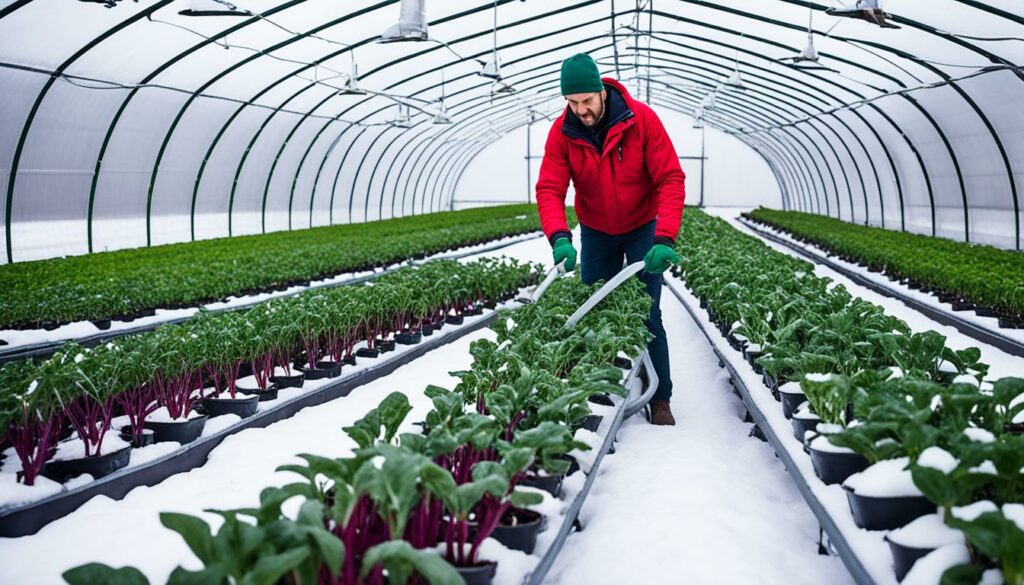
Select crops carefully based on your local climate and your greenhouse. In warm, sunny places, you can try growing warmer weather crops. A 14 by 24-foot winter greenhouse can grow fresh vegetables all year. This means you’ll always have fresh veggies, even in winter.
Think about these points carefully to get the best from your winter greenhouse. We also have a table with recommended winter crops and why they’re good:
| Crop | Main Benefit |
|---|---|
| Kale | Highly nutritious and cold-hardy |
| Spinach | Fast-growing and rich in vitamins |
| Carrots | Robust root vegetable that avoids frost damage |
| Beets | Cold-tolerant and versatile for cooking |
| Scallions | Easy to grow in varying temperatures |
Pick the right winter crops and take good care of them. Doing this will make your greenhouse very productive in winter, full of fresh food. This smart strategy keeps your winter greenhouse working hard and well even in the coldest months.
Adding cost-effective upgrades can make your greenhouse more efficient and green. It’s important to get help to pay for these changes. Financial support for upgrades makes a big difference.
Getting financial help is key to putting in energy-saving solutions. The USDA’s Rural Energy for America Program (REAP) grant is a good source of funds. It helps a lot during the winter, when the cost of heating and lighting goes up. Also, many power companies give cash back for using LED lights instead of traditional ones. This cuts costs even more.
Don’t forget about tax breaks and rebates when you upgrade your greenhouse. Businesses that put money into renewable energy or energy efficiency improvements can get tax credits and deductions. This includes things like special fans, insulation, and wind turbines for greenhouses. Local utility companies also have big rebates for improving your HVAC system. This makes upgrades more affordable and useful.
For those on a budget, cheap insulation options are a must. Placing a thermal screen on the roof and walls can cut nighttime heat loss a lot. Using bubble wrap or foam board is also good. They are cheap ways to keep the heat in and lower your energy bill.
| Measure | Benefit |
|---|---|
| Thermal Curtains | Reduce energy needed to heat the greenhouse, leading to significant cost savings. |
| LED Lighting | More energy-efficient than HPS lights, often eligible for utility rebates. |
| REAP Grant | Provides financial support for upgraded energy-efficient systems. |
| Bubble Wrap Insulation | An affordable option that helps retain heat and reduce heating costs. |
Thinking about geothermal heating is smart. These systems use the Earth’s steady heat under the surface. They are a smart and efficient way to warm your greenhouse in winter. Mixing these strategies helps make your greenhouse better for the environment and your wallet.
For successful crop growth in greenhouses, keeping the right temperature and humidity is key. Crops usually do best in temperatures between 64 and 75 ºF. This ensures they get the warmth required for healthy growth. Humidity is as important, with about 80% relative humidity being ideal for most plants.
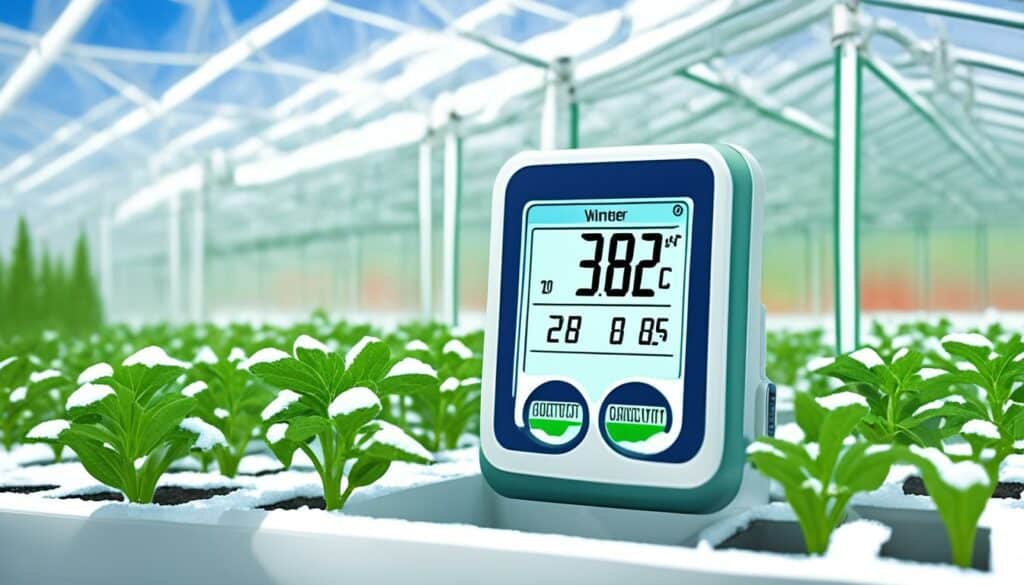
If temperatures or humidity go too high or low, crop quality goes down. Automated controls and thermostats are great for watching and adjusting these factors. They keep things just right, which is crucial for a stable, healthy growing area.
Thermostats are vital for regulating greenhouse temperatures. Programmable options help set the perfect conditions for plants. The latest models connect to control systems, making adjustments as needed. This boosts how well the greenhouse works.
Humidity control is also critical. Too much humidity can cause plant diseases. Systems like misting or high-pressure fogging help keep humidity in check. Using good drainage and the right humidifiers or dehumidifiers can balance humidity. This makes for a better growing space.
Ventilation is vital to prevent too much heat and manage humidity. Both natural and mechanical airflow solutions, including fans, work well. They create a uniform climate that supports plant health. Good ventilation also stops the greenhouse from getting too hot.
| Key Control Methods | Benefits |
|---|---|
| Automated Temperature Controls | Makes sure the temperature is just right for plants to grow well. |
| Humidity Sensors | Give accurate data to help manage humidity effectively. |
| Proper Ventilation | Stops the space from getting too hot and keeps humidity balanced. |
| Fogging Systems | Adds moisture to the air without harming plants, via tiny droplets. |
There are many types of greenhouses perfect for winter agriculture, for different climates and needs. Metal-framed glass greenhouses stand out for their strong build. They let in a lot of light, crucial for the shorter days of winter.
Then, there are polycarbonate greenhouses. They keep the heat well and are easy to handle. This makes them good for small gardeners or big farms. Plus, polyethylene greenhouses are a smart choice since they are budget-friendly and adaptable.
Wooden-framed glass and wooden-framed polyethylene greenhouses mix old and new design features. They keep the winter farming environment nice and warm. This is great for growing winter crops like root veggies and salads.
Now, dome greenhouses are becoming more popular. These unique shapes are strong and easily shed snow. They are often seen in personal gardens, making them great for winter growing.
Greenhouses help extend the growing season in colder places. This allows for year-round farming of veggies and herbs. Techniques like deep mulching and using special covers can help keep the temperature just right for the plants.
| Type of Greenhouse | Material | Best Attributes |
|---|---|---|
| Metal-Framed Glass | Glass | Durability, Light Transmission |
| Polycarbonate | Polycarbonate | Insulation, Lightweight |
| Polyethylene | Polyethylene | Cost-Effective, Versatile |
| Wood-Framed Glass/Polyethylene | Wood, Glass/Polyethylene | Aesthetics, Warmth Retention |
| Dome Greenhouses | Various | Strength, Snow/Wind Shedding |
Each greenhouse type offers different benefits. It’s important to think about the local weather, your space, and what you want to grow. This way, you can have a successful farm even in the cold of winter.
Cold weather needs cheap and smart ways to heat small greenhouses. The goal is to keep plants growing strong without spending too much. Here’s how you can heat your greenhouse without breaking the bank.
Electric heaters are easy to set up and use. They are perfect for heating small spaces like a greenhouse. MONT brand is known for making heaters that last long and work well.
Adding insulation helps keep the warmth inside. This means you can save energy and money.
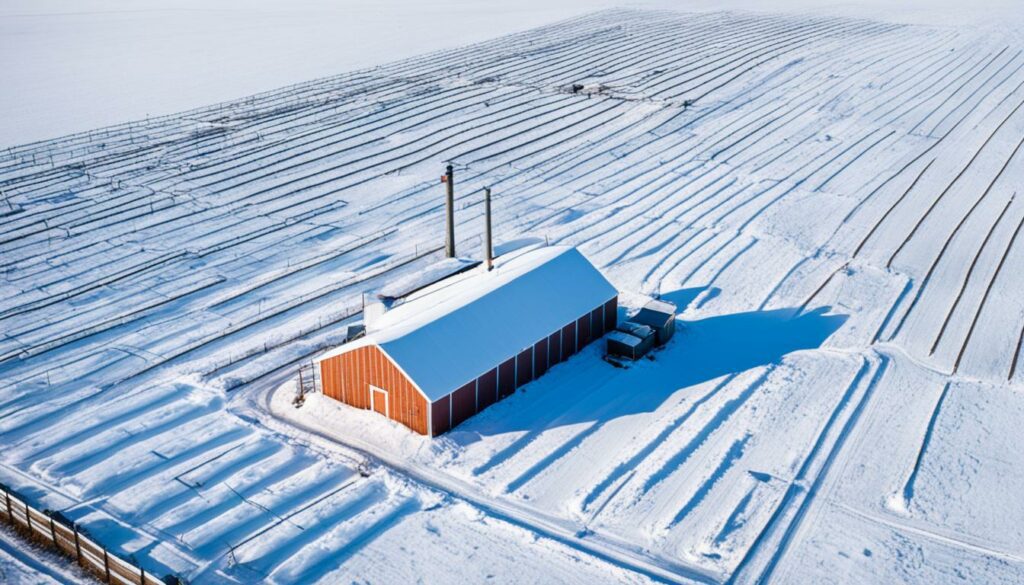
Cold areas might need more heat, like what propane or natural gas heaters offer. Propane heaters are good for heating larger areas. Natural gas heaters keep the heat steady and can control temperatures with a thermostat.
However, both need good ventilation to keep the air safe for plants. This stops harmful gas from hurting the plants.
| Heating Method | Advantages | Disadvantages | Ideal Greenhouse Size |
|---|---|---|---|
| Electric Heaters | Easy installation, reliable, efficient with insulation | Higher electricity costs | Small to medium |
| Propane Heaters | High heat output, cost-effective | Requires ventilation, gas emissions risk | Medium |
| Natural Gas Heaters | Consistent heating, thermostat control | Ventilation needed, potential gas emissions | Medium |
These methods can make heating greenhouses more affordable. The key is to find a balance between cost and keeping the perfect conditions for your plants in winter.
Greenhouses can struggle with pests and diseases. So, it’s key to have a solid plan. This includes knowing what plants are at risk, watching for pests, and keeping the environment right. Good advanced pest management is vital, especially in winter.
For strong disease management in greenhouses, check plants often. Make sure fresh air can get around them. Also, space plants out and keep new ones separate at first. This helps stop pests and diseases from spreading.
Picking the right plants can help fight off pests. Trying different types can help. And catching problems early is easier on the plants. You can use helpful bugs or change how you grow things to control pests with fewer chemicals.
Using insect screens and sticky traps stops pests getting in. This active approach in advanced pest management boosts crop health. It also keeps your greenhouse working smoothly.
The greenhouse’s climate affects pest growth. Keeping the right temperature and humidity is key. For example, aphids like warm, moist settings. Acting fast with control methods like soaps or friendly bugs can save your plants.
To tackle fungus gnats, manage water use and consider nematodes. Whiteflies need clean spaces and barriers to stop them. Also, tools like soaps, traps, and helpful wasps can control these pests.
Spider mites require careful management too. This includes cleaning their webs off and keeping plants clean. Watch and adjust the climate closely.
Diseases like powdery mildew are a foe. More air and less dampness help keep them away. This makes powdery mildew easier to handle.
In the end, being always alert and using smart, gentle methods is key. This stands true in both advanced pest management and disease management in greenhouses, especially in winter.
Growing crops in unheated greenhouses during winter is tough. It needs special care and smart insulation methods. With the right steps, we can keep plants healthy, even when it’s icy outside.
To keep crops warm, using insulating materials is a must. Bubble wrap or burlap can add an extra shield against the cold. Plants like Swiss chard aren’t just tough; they also help keep the greenhouse warm with their big leaves.
Keeping the heat in with thermal mass is a solid plan. Things like water barrels or dark containers soak up warmth during the day. Then, they slowly release it at night, creating a cosy spot for crops. Placing these items right helps spread warmth all over the greenhouse.

Row covers and mulch are game-changers for protecting plants in winter. Crops like spinach and parsley love them. These covers keep veggies safe from extreme cold snaps. Plus, carrots do well in the frost. A layer of mulch around them makes their roots strong and sweeter.
By mixing insulating techniques and thermal mass utilisation, growing crops in unheated greenhouses in winter becomes doable.
Winter greenhouse success involves many key points working together. Insulating your greenhouse and using smart heating keep it warm for plants. You must also control temperature and humidity with ventilation and moisture checks.
Pick the best plants for winter, like leafy greens and certain brassicas. These not only survive but thrive in colder weather. For better results, use methods like rotating crops and hydroponics. And, make use of tech that handles climate, water, and light to keep everything in top shape, increasing productivity.
Looking for financial help and advice from others can make a big difference. It can lower costs and improve the efficiency of your greenhouse. These steps can turn winter gardening into a truly satisfying experience. With the right approach, winter can be a time of plenty and success, showing off top-notch greenhouse care.
Winter greenhouse care involves good insulation, effective heating, and the right light. It’s also key to keep the right temperature and moisture. Pick good plants and know how to let air flow through well.
Great materials include polyethylene and triple-layer polycarbonate for curtains and windows. It’s important to use materials that keep the heat in to save energy. Clear bubble wrap over glazing panels also helps.
Geothermal heating uses the earth’s natural heat to keep the greenhouse warm. This method reduces energy use and keeps a steady growing space temperature.
Infrared heaters warm plants directly but not the whole greenhouse. They’re great for saving energy while keeping your plants cosy.
LED lights are perfect because they save energy and give plants the light they need. It’s also important to understand the right type of light for your plants.
Automated systems adjust the greenhouse’s climate without you having to. They save money, time, and help plants grow in the best conditions.
Winter greenhouses are great for growing tough plants like greens, herbs, and certain vegetables. You can even grow some summer crops if your greenhouse stays warm enough.
Yes, there are grants and tax benefits that help with the cost of making your greenhouse more energy-efficient. Look into programs like the USDA’s REAP for support.
Use programmable thermostats for temperature and tools to control humidity. Good ventilation is also key to balance the indoor climate.
Geodesic dome greenhouses with glass or polycarbonate are great for winter. They are strong against snow and keep the inside warm.
For smaller spaces, electric heaters work well. Larger greenhouses can benefit from propane or natural gas heating. Just make sure to ventilate heaters properly for safety.
Inspect plants often and keep the air moving. Also, use tactics like separating new plants, setting up plants right, and choosing natural pest control.
To grow crops without heating, try deep mulching or covering with materials like row covers. You can also use thermal mass like water-filled barrels to keep some crops growing.“`
This HTML section provides a comprehensive FAQ based on the provided structure and ensures the inclusion of key aspects of winter greenhouse management.